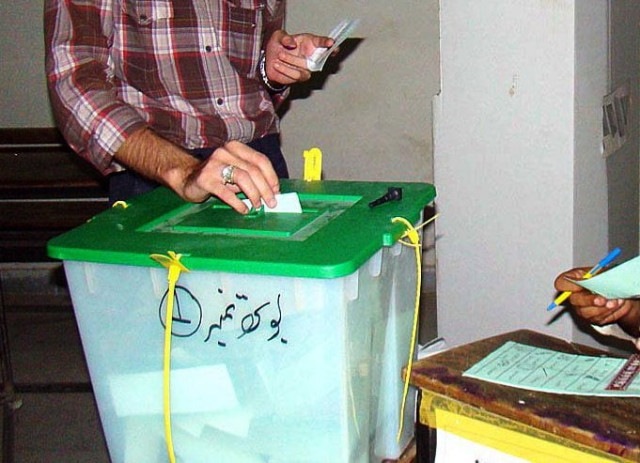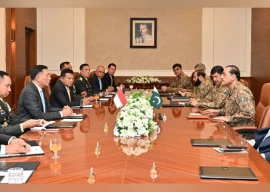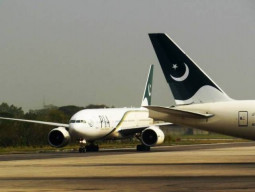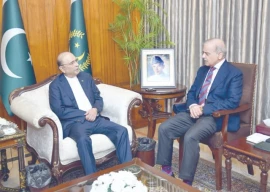
The by-election campaign, which ends on Thursday night, has seen several other ‘firsts’ in the region with the traditional ceremony of slaughtering animals to attract voters and for good omen foregone.
Hairan Mohmand, a local who has participated in elections in the area since 1997, said that they have witnessed a change in how election campaigns are run in the run-up to Saturday’s by-elections.
The biggest change, he said, was that a majority of tribesmen had stepped forward to participate in the rallies hosted by different political parties instead of flocking to the feasts offered by wealthy tribesmen who run as independents.
“In the past, candidates used to attract supporters by slaughtering a large number of cows and buffalos in every village,” Hairan said. “This time, however, this trend has tremendously declined.”
Mohmand told The Express Tribune that political candidates have used spaces such as mosques and their ‘hujras’ (residential compounds) to address gatherings. Some have even resorted to carrying out a door-to-door campaign to attract voters.
Many NMD polling stations lack ramps
“Earlier, candidates used to visit select hujras and mosques to address their supporters but this time around, they have made visits to all hujras, mosques and houses to appeal to the voters. This had quite an impact on the voters,” Hairan said.
A report compiled by the Free and Fair Election Network (FAFEN) showed that the ruling Pakistan Tehreek-e-Insaf (PTI) had held the most rallies with 39, followed by independents at 33 while the Jamiat Ulema-e-Islam Fazl (JUI-F) held nine while the Awami National Party (ANP) and the Pakistan Peoples Party (PPP) held seven each. PK-106 Khyber-II saw the most rallies by all parties followed by PK-107 Khyber-III.
Rise of social media
Mohmand Press Club President Fakhr-e-Alam Mohmand said that a unique feature of the current election campaign was the use of social media by candidates.
“Contrary to the past when politicians relied heavily on print and electronic media, the current campaign saw many candidates hire their own social media teams to update the social networks of candidates with their electioneering activities,” Fakhr-e-Alam said.
Ostensibly a nod to the general trend observed during the general elections last year, the move came as a surprise as many areas in the newly-merged tribal districts do not have access to the internet.
When asked about the purpose of relying on social media for the electioneering campaign under the circumstances, Fakhr-e-Alam said that many candidates are unaware of the limited penetration of social media.
Election rallies
Gul Hussain Mohmand of a local press club told The Express Tribune that in the past, there was a ban on political activities in the erstwhile federally administered tribal areas (FATA), so no political rallies could ever take place.
ECP refuses to delay PK-115 election over complaint against PTI candidate
“Recently, we saw political leaders such as Bilawal Bhutto Zardari and Asfandyar Wali Khan came to FATA to hold large-scale political gatherings to convince people to vote,” Gul Hussain said. “The independent candidates didn’t lag behind either and held big rallies of their own to entice supporters.
“The political environment was charged up in a way that had never been witnessed before,” he said.
Women’s participation
Unlike the past, the present election campaign also saw an increase in women’s participation in the voting process and a better turn out is expected this election.
“Earlier, women were not allowed to vote in most areas of ex-Fata except for some urban parts. There too, the percentage of female voters was less than 10 per cent,” Mehboob Sher Mohmand of FAFEN said. “This time, however, more women have participated in the process than ever before.”
He further added that earlier, tribesmen were bound to vote for their co-tribesman but now there is no such obligation and people are free to vote for the candidates of their choice.
Voting for peace and prosperity
For many years, the tribal districts had to witness a lot of violence, first due to militants and then a war to evict the militants. But now, there is no such threat and political leaders freely held public gatherings and campaign rallies across the region – even at nighttime.
“During the 2008 and 2013 elections, every candidate used to receive threats and there were no polling stations,” Awami National Party (ANP) candidate Nisar Mohmand recalled while talking to The Express Tribune.
Today, however, peace has returned to tribal districts and voters have greater awareness about their voting rights.
“The people of the tribal districts are not only voting for their leaders but they are voting for peace and prosperity in the region,” he concluded.
In the FAFEN report, around 87% of candidates reported that their voters were freely able to campaign and canvass while of the 3,132 citizens interviewed, most said they attended rallies free of any coercion.
Published in The Express Tribune, July 19th, 2019.












COMMENTS
Comments are moderated and generally will be posted if they are on-topic and not abusive.
For more information, please see our Comments FAQ